Are You Wondering How To Use A Spinnerbait? Or How To Work A Spinnerbait Over Grass, Logs, or Points? Well, All These Questions Are Answered And Much, Much More!
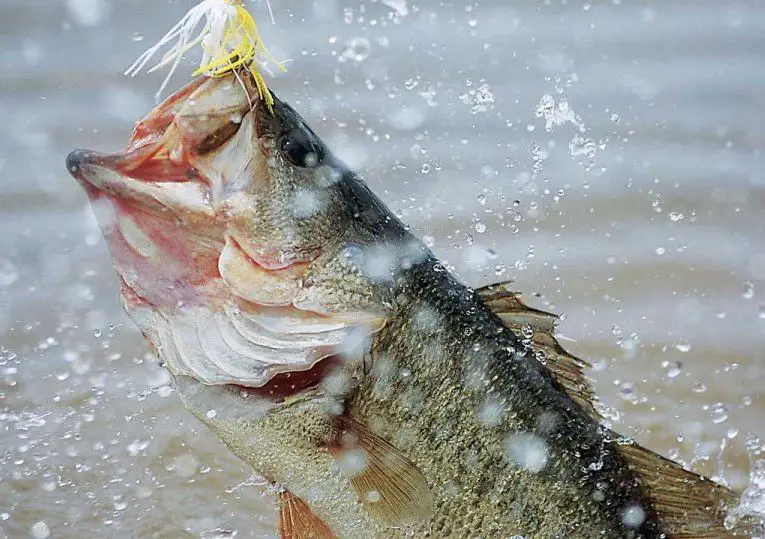
Everyone’s talking about spinnerbait fishing, right?
We all know the frustration of fishing the perfect spot only to have a giant bass follow your bait and not bite… or even worse your spinnerbait start to roll over on itself and spook off the fish…
But what almost no one understands about spinnerbait fishing is the concept of how to fish a spinnerbait the right way.
It’s not casting your bait out a million times that helps you catch bass, it’s learning how to use a spinnerbait in the ideal setting that no one is talking about.
Combining the right type of spinnerbait with the correct conditions will put you in a position to start catching bass quickly…
And that can happen even if you are a weekend warrior bass angler, as long as you’re also using these tools and tips that we given you in the report below.
Key Takeaways
For most anglers learning how to use a spinnerbait can seem pretty exciting, yet somewhat intimidating. Here is a quick and easy to follow list to help you get started fast!
- The best weather conditions to use a spinnerbait are when it’s breezy or windy.
- The best locations to fish a spinnerbait are the ones with structure.
- A stained water clarity tends to be the best for fishing a spinnerbait, which lets you maximize the bait vibration and flash, without spooking the fish.
- The best spinnerbait color combinations are based on the type of baitfish in your lake.
- And much, MUCH, more!
How to use a spinnerbait
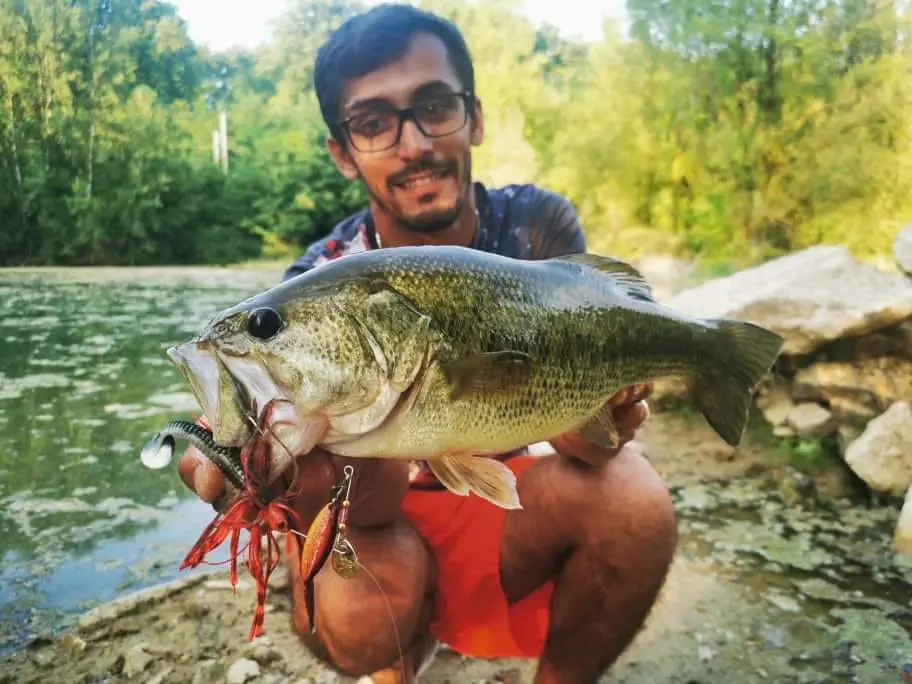
Understanding what a spinnerbait is and what it’s designed to do is the foundation of how to fish one, or more importantly, how to get the most out of your spinnerbait.
If you’re a little unsure what is a spinnerbait, to learn all the subtle differences click here to read this report first, then come back to this report later.
Then making use of what it does helps improve your cast to catch ratio.
Simply speaking the blades rotate and the wire vibrates, causing the individual strands of the skirt to shimmy and flow. The bass think it is a small school of baitfish and they’re triggered to attack your lure.
Most new anglers just cast the spinnerbait out and reel it back in…
Yes, this should suffice to capture a few. Most people, on the other hand, do not have the true insider knowledge of what is the absolute best way to get more bites… and it’s not their fault.
Many “pro” anglers or “YouTue bass gurus” will only tell you the basics on purpose. They want to be the ones who catch all the big bass, not you.
I’m here to level the playing field. What I’m going to share with you today, the know-it-alls do not want to know about, and I’m sure I’m going to get a few nasty messages, but I don’t care.
Fish a spinnerbait in the wind

When the wind comes up either in the spring or in the fall, a lot of fishermen will pack it in and return home.
This not only is a huge mistake, you could be missing out on an amazing day of fishing.
While it’s true that windy days create difficult fishing conditions, blowing away areas, making it difficult to cast and manage the boat – but the wind also activates the fish, making bass trigger into a feeding frenzy.
Another mistake bass anglers will make is fishing a spinnerbait in calm, flatwater conditions.
A spinnerbait must have water turbulence. Breezy conditions, wind, river current, flooding, or water runoff after a recent rain storm are all perfect examples of this.
Most of the time you’ll be dealing with breezy or windy conditions.
Windy turbulent water breaks up the shape of the spinnerbait, especially when fished close to the top of the water column…
The water will break up the silhouette and force the bass into making a split second decision to attack your lure or let a potential meal pass by.
When fishing with a spinnerbait, all you need are blade options: a double willow blade, or a small leading Colorado blade with a larger trailing willow blade..
The willow blade is a long, thin blade that resembles a narrow leaf. It also has a stronger flash, which is useful in cloudy and windy circumstances.
The Colorado blade has a more rounded form and is a thumper in terms of water displacement.
In most cases, you cannot go wrong with a double willow blade spinnerbait in windy conditions, although they may both be successful in severe winds.
A 1/2 ounce will probably be the most versatile for you and can be fished in almost every scenario.
If conditions turn from breezy to very windy, the wind will cause your lure to swim higher in the water column…
The solution to this problem is to increase the weight of your spinnerbait another ¼-½ ounce, but keep the blade size the same.
Helpful tip: Look for deep pockets that face the wind. Often the wind will blow mats of floating debris and will collect the backs of these pockets. Bass will hold under these mats."
Summary:
- Breezing/windy conditions/ water turbulence = optimal spinnerbait conditions.
- Target Shallow Water – Baitfish are forced into the shallows as the wind kicks up, and bass follows suit. The wind also stimulates the whole water column, increasing the aggression of the bass.
- Windy conditions – increase the weight of the spinnerbait, keeping the same size blades.
- Keep Charged Trolling Motor Batteries – If you’re using a trolling motor in a boat or kayak, you’ll want to make sure the batteries are well charged. If you have ever been in circumstances when your trolling motor has died and you’ve become stranded on the bank in strong winds…it’s not enjoyable.
- Use A Drift Sock To Slow Your Drift – Consider using a drift sock or drift bag to slow your drift so you avoid draining your trolling motor battery.
Wind affects fishermen much more than it affects fish."
Peter Thliveros MLF Pro
Where to fish spinnerbaits?

Most anglers make the mistake to not take the time to find the best locations to target bass with a spinnerbait.
The ideal locations to fish spinnerbaits are areas that can provide good ambush points for bass.
There are a few locations you should check you lake for:
- Points with high ridges
- Stumps
- Laydowns
- Brush piles
- Vertical timber
- Boulders or rock piles
- Grass mats
- Submerged weeds
- Manmade structure/ habitats
- Docks
- Bridge pilings
- And much much more…
What do all these locations have in common?…..
A bass can hide in it, on it, or behind it. Find structures like these and you can fish a spinnerbait through it.
How to fish spinnerbaits around cover
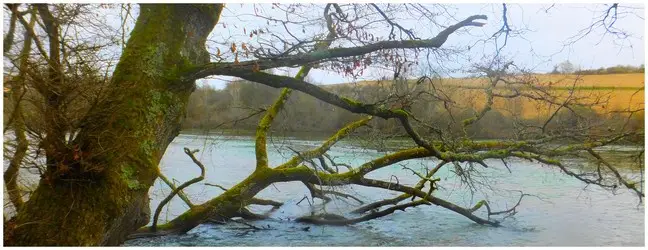
Once you locate an optimal spot, cast out your lure and start your retrieve. Most importantly guide it so it intentionally deflects off cover…
This is by far the greatest and easiest way to generate a reaction strike.
This technique cannot be overstated: it’s crucial to make the bait bang into, bounce off, roll over the top of, or tear free of the cover.
When this happens, the lure comes to an abrupt halt.
Consequently, the blades’ spin and vibration changes, causing the skirt to flare wildly.
Once the spinnerbait makes contact, most professional anglers have been witnessed doing one of two things:
Some anglers will continue to reel in the bait so that the fish don’t get a good look at it.
Whereas, others will give the lure a split-second pause (allowing the spinnerbait to fall briefly) after the lure makes contact with the cover.
Helpful tip: A word of warning, If you are fishing your lure through heavy cover, and you pause it after it makes contact, it can fall into the ‘secondary-cover’ and become hung up.
For example, you are fishing a large laydown with a ton of secondary branches. This would not be a good place to pause after contact, just keep reeling the lure in.
However, ideal areas to pause the spinnerbait after making contact is bridge pilings, dock posts, single large log, ridge, isolated boulder, steep hump or rock pile.
Summary
- If a bass can hide in it, on it, or behind it, fish a spinnerbait through it.
- It’s crucial to make structure contact with your spinnerbait.
- You are strongly encouraged to still pause after contact, just make sure there is no secondary cover it can get hung up on.
What is the best color spinnerbait?
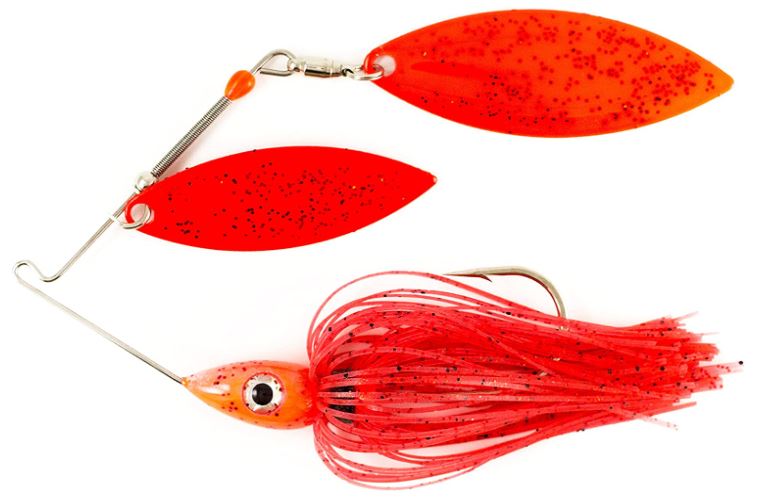
In its most basic definition, for dirty water, muddy or murky water, a dark spinnerbait is the best choice. It can be black, blue, or purple.
A shad pattern, white, and chartreuse will also produce if the water is clear.
However, there are so many other circumstances that would justify a change in blade or skirt color.
Below is a guide for you to help you decide what spinnerbait color works the best.
| Season / Situation | Spinnerbait Blade color | Skirt Color |
|---|---|---|
| Spring - Clear water | Chrome | Shad pattern* or white |
| Spring - Murky or dirty water | Gold, red, orange | Dark: Blue, black, or red |
| Spring - fishing around bluegill beds | Gold, blue, black or purple | Bluegill pattern, or chartreuse |
| Summer - Clear water | Chrome | Shad pattern, all white, white/chartreuse |
| Summer - Murky or dirty water | Gold or copper | white, chartreuse, black |
| Fall - Clear water | Chrome | Shad pattern, all white, white/chartreuse |
| Fall - Murky or dirty water | Gold, blue, black or purple | Shad pattern , all white, Bluegill pattern, or chartreuse |
| Winter - Clear water | chrome, brushed nickel, black, or brown | Shad pattern, bluegill pattern, craw pattern |
| Winter - Murky or dirty water | Gold, red, orange, or black | White, black, brown, or red |
How fast do you reel a spinnerbait?
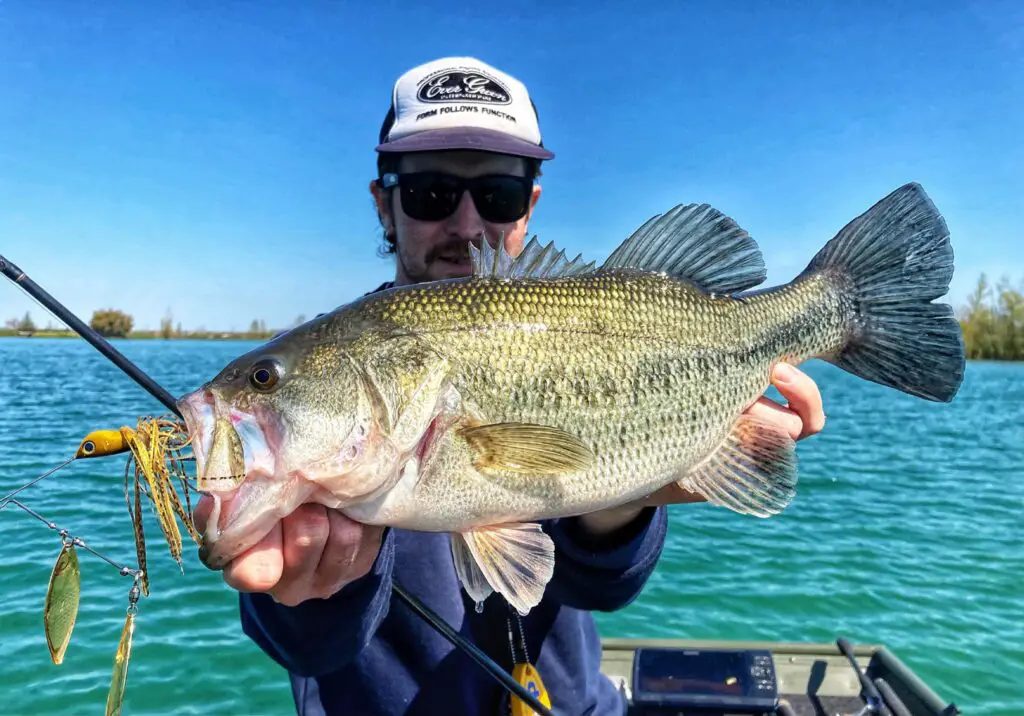
Option 1: Most of the time the best retrieval speed is going just fast enough to make blades spin.
If you fish your spinnerbait too fast it will roll on its side. If you see this you have to slow down your retrieval speed.
Option 2: Changing the retrieval speed when there is no cover around or between objects might provoke a reaction strike.
The most crucial aspect of this is to utilize your reel rather than the rod…
Turn the reel handle two or three times rapidly when reeling the spinnerbait back, then return to normal reeling pace after that.
This causes the skirt to pulse and the blades and vibrations to rise and then decrease quickly.
Every five to ten feet, or anytime the spinnerbait is over any submerged structure such as weed beds.
Doing this causes the bait to behave unpredictably and cause a reaction strike.
Option 3: Reel in your spinnerbait as fast you can (known as “burning”) over shallow flats and submerged weedbeds.
Spring and summer are the best times of year to do this technique.
It may seem counterintuitive, but using a heavier spinnerbait fitted with smaller blades is the best for this technique.
The heavier spinnerbait will not roll during the fast retrieve.
But a word of warning: You have to start reeling it in the moment it hits the water, otherwise it’s going to sink and get hung up.
Lastly, do not worry about reeling it in too fast. The bass are easily 3-4x faster than your spinnerbait… no matter how fast you think you’re reeling it in.
Summary
- The best retrieval speed is going just fast enough to make blades spin.
- Changing the retrieval speed might provoke a reaction strike.
- Burning your spinnerbait over shallow flats can elicit bone-crushing strikes
How to fish a spinnerbait in grass?
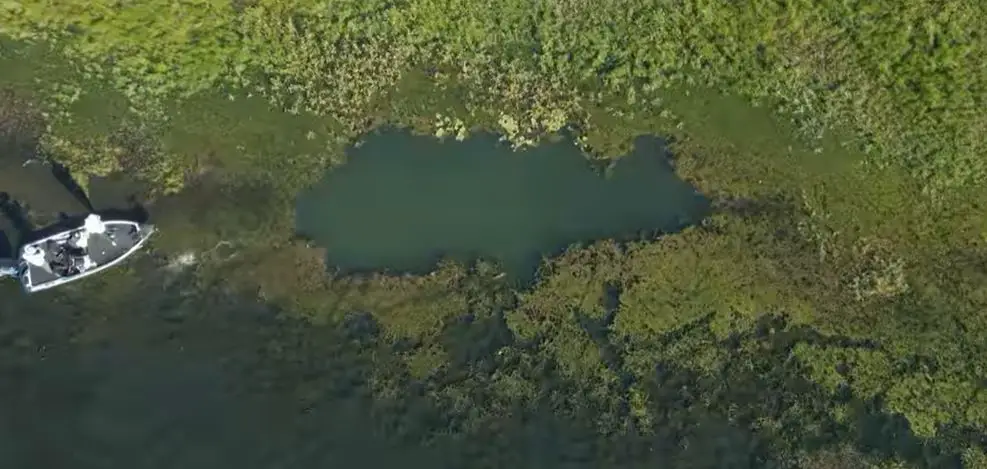
Fishing a spinnerbait around grass is an often overlooked technique.
In most areas of the country, lakes will have submerged patches of hydrilla that bass love to hide in.
Our research has shown most professionals know how to fish a spinnerbait in grass in various ways.
The most common technique mentioned would be ticking the tops of the weeds, especially if the weeds are a foot or two down.
It was discovered that pulling the spinnerbait through the grass with the tip of your rod rather than the reel is simpler and more successful.
Another technique is to draw the spinnerbait a bit and tighten the slack line, then pull the spinnerbait a little more and tighten the slack line, and so on. Not pulling it hard or forceful; instead, use the rod tip to draw it slowly and steadily.
An additional technique is to get the bait as close to the clumps as possible.
The majority of bass appear to hit when it gets briefly hung up and yanks free or goes past a cluster. Most of the time, they’re sitting very next to the grass clumps.
As you’re reeling it by a clump, give the bait a jerk to create some erratic action.
The pros rarely just throw it out there and reel it in calmly.
Give it a jolt or two, or even a little pause to let it fall.
Another great technique is running a spinnerbait just beneath the surface and creating a “V” wake over a weed bed.
This seems to perform best on a spinnerbait with a big cupped Colorado blade and a curly tail trailer for more movement.
The last technique is to keep your rod tip high and allow the blade to just break the surface and roll over, as baitfish do. It’s kinda like you’re fishing your spinnerbait topwater style
Problem: Your spinnerbait keeps getting mucked up with weeds when fishing over grass.
Solution: First, downsize the weight of your spinnerbait, because it’s likely too heavy.
In sparse hydrilla, use twin blades or a single willow leaf spinnerbait until the foliage becomes too dense.
Remove the Colorado blade, which is the tiny one. This makes it much easier for your spinnerbait to go through the grass and catch more fish.
With the Colorado blade removed, just make sure the spinnerbait doesn’t roll over.
If your spinnerbait is rolling, go to a smaller willow blade in a #5 or #5.5 size, but not bigger.
Here are some weedless spinnerbaits you to consider...
#ad / Images from Amazon Product Advertising API
Do you use a trailer on a spinnerbait?
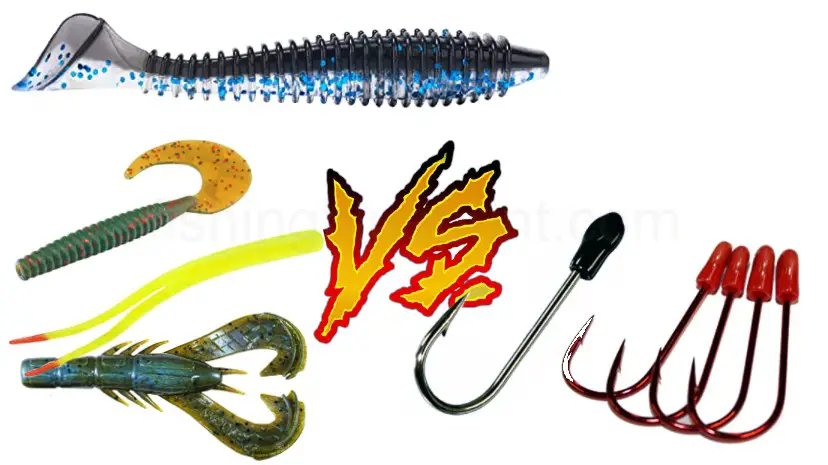
If you really want to know how to use a spinnerbait, there are two forms of trailers on spinnerbaits, trailer hooks and soft plastic trailers.
Trailer hooks are additional hooks that are attached to the main bait hook. Essentially giving the bait two hooks.
A soft plastic trailer is a soft plastic attractor that is threaded onto the hook. As the spinnerbait is swimming through the water the trailer will shake, shimmy, or thump.
There are several soft plastic trailers on the market. Here are just a few examples:
- Twin tails
- Single tail grubs
- Soft plastic swimbaits
- Craw baits
In a poll we performed, we asked anglers who stated they were confident in using spinnerbaits, when would they use a trailer hook versus a soft plastic trailer…
The vast majority of them said the length of the spinnerbait arm helps determine what type of trailer is used.
Most said they’ll choose to use a trailer hook if the wire arm carrying the blades is longer AND if the type of cover is sparse.
If the location you’re fishing has sparse cover (dock posts, rock piles, boulders, bridge pilings) then adding a trailer hook will increase your chances of catching a fish…
But, it also increases the chances of getting hung up if you’re fishing in heavy cover.
If the spinnerbait wire arm is shorter, though, there’s no need for a hook, and a soft plastic will suffice.
Problem: You notice you’re getting short strikes with a spinnerbait, but you only have long arm spinnerbaits and the cover your fishing in is thick. You’re concerned that adding an extra trailer hook will hang up your spinnerbait.
Solution: Since you do not have a short arm spinnerbait, you can do a couple of things…
Switch out your large trailing blade to a smaller blade.
Or… use a weedless underspin jig. It’s more compact and still has the flash of a spinnerbait
Or… switch to a soft plastic swimbait or swim jig.
Here are some spinnerbait trailer hooks you to consider...
#ad / Images from Amazon Product Advertising API
Here are some soft plastic swimbait trailers for you to consider...
#ad / Images from Amazon Product Advertising API
Here are some soft plastic grub trailers for you to consider...
#ad / Images from Amazon Product Advertising API
Here are some soft plastic craw trailers for you to consider...
#ad / Images from Amazon Product Advertising API
Make Your Own Spinnerbait
Check out this great video above, it goes over how to change out your spinnerbait blades so you can fish the best color spinnerbait, which provides you more chances to get bit!
Here’s the list of materials mentioned in the video.
What's the best spinnerbait rod
An ideal spinnerbait rod for any serious angler would be a medium-heavy casting rod, 6’8″ to 7’2″ long, with a fast action tip.
You’ll probably do most of your fishing with this rod, so it’ll be the workhorse getting the most use.
These rods are a little heavier power, a little longer, and should have a very sensitive tip.
It’s an interesting combination.
Having a strong backbone will also allow you to move the spinnerbait, rip it from vegetation hangups, and set the hook with ease.
The fast action tip, will detect even the smallest of bites.
Additionally, using a longer rod aids in lure action by raising the tip of the rod. The longer the rod the more line you move when you raise the tip.
By the way, if you really want to catch a TON of bass, we created an Official Buyers Guide to Choosing the Best Rod for Spinnerbait Fishing it lays it all out for you! Check it out here click HERE to learn more!
>> Learn More: Best Spinnerbait Rod Rod Buyers Guide 2022 (St. Croix, Shimano, Diawa, and More!)
What's the best spinnerbait reel?
The ideal spinnerbait reel should have a moderate to fast retrieve gear ratio (6.3:1 to 7.3:1).
The best reels should have the benefits of long casting distance, backlash resistance, lightweight, and durability.
A good spinnerbait casting reel should have a strong drag, which gives you the confidence to set the hook and pulls out any bass from the thickest of cover.
Here are some quality spinnerbait reels for you to consider...
#ad / Images from Amazon Product Advertising API
Checkout These Other Spinnerbait Articles...
- BEST Spinnerbaits for Bass 2022: Top Picks the Pros Refuse to Talk About
- [Official] Buyers Guide to Choosing the BEST ROD for Spinnerbait Fishing
- Dirty Secret On HOW TO FISH A Spinnerbait [Even Your Pastor will be Envious!]
- Discover! What Is A Spinnerbait And Other Secrets That Could Help You Fast!
- How To RIG A Spinnerbait – 30+ Ways To Choose, Set Up, And Tie On A Spinnerbait The Right Way!
FAQ
How deep can you fish a spinnerbait?
Most new anglers learning how to fish a spinnerbait think spinnerbait fishing is mainly done in less than 10 feet of water… but that’s just not true!
You can fish a spinnerbait at nearly any depth.
With very little additional work on your part, you can alter the bait run virtually exactly at the target depth once you know it.
However, running your spinnerbait at a depth of 10+ feet you’ll probably need to alter the bait a little, by switching out to a smaller set of blades.
You can also buy a spinnerbait specifically designed to run deep, such as the Strike King Bottom Dwelling Spinnerbait.
It has narrower, slightly smaller blades that help keep the bait from riding up too much off the bottom during the retrieve.
Do spinnerbaits work in the ocean?
Absolutely! If you’re fishing in one of your local harbors or bays, there’s a very strong possibility you’ll be in an area where there’s a lot of eelgrass.
This grassy region is where Calico Bass, Sand Bass and Spotted Bay Bass like to hide and hunt for food.
The spinnerbait is a very efficient technique for catching fish around this submerged saltwater grass.
A slow retrieve hugging the bottom is generally enough to elicit a large strike.
Occasionally, you get grass on your lure, but that only means you’re fishing the correct depth!
The best anglers will cast out as far as they can and let the bait sink to the bottom before working it back up and over the tops of the grass.
What to do if a bass short-strikes your spinnerbait?
When bass strike a spinnerbait short, they frequently strike the blade rather than the hook.
The first thing that comes to mind is to bend the spinnerbait down to bring the hook closer to the blade.
You can sometimes add a trailer hook to have two hooks close to the blade.
If they’re still striking the blade, it’s possible you’ll need to replace the skirt.
How to clean spinnerbait blades?
Have you ever wondered how you put the shine back on your old spinnerbait blades. And how do you keep them shiny?
There are four popular ways to know how to clean your spinnerbait blades and keep them polished and shiny.
- Brasso. It’s easy to find at nearly any home improvement store. It is mind-blowing how easy it brings the shine back.
- MAAS Polishing Creme. This stuff works on nearly all common spinnerbait blades. A littel goes a long way. You can pick up a 2 oz tube at Walgreens or Amazon for around $8-$10 dollars.
- Mr Clean Magic Pad – Just get it wet and it acts like a polishing cloth
- 100% vinegar and cotton wipes.
Do colored spinnerbait blades work?
Yes, they do in specific situations.
Using colored spinnerbait blades is similar to the general spinnerbait skirt color hypothesis: When light penetration is limited (like in muddy water), typical metallic blades will not reflect as much light.
So anglers must adapt and switch to solid, vibrant or fluorescent colored blades.
Where do you put spinnerbaits?
The best and cheapest way to store spinnerbaits is in flat spinnerbait box containers.
These are similar to standard tackle boxes, except instead of simple dividers, they have notches cut into them to allow you to line up the spinnerbaits in the box.
Here are the advantages and disadvantages.
These bait boxes can efficiently store a large number of spinnerbaits.
The boxes may be stored in the same location as your other boxes, which is ideal for boats with box slots.
Some of the less expensive boxes, spinnerbaits will tend to shift around far too much, which could cause unneeded scratches on the blades.
If you buy a spinnerbait storage box, I strongly recommend you avoid a spinnerbait storage box with no divisions at all in them.
No-division boxes are a problem because the spinnerbaits are stacked on top of each other, making it difficult to remove them and even more difficult to put them away.
To make matters worse, it might be difficult to see each spinnerbait and rapidly choose the right spinnerbait for the job.
Personally I use the Plano SpinnerBait StowAway Multi-Compartment Box. I don’t have shifting spinnerbaits and the box holds up really well.
More articles just for you...
Selecting Early Summer Bass Fishing Lures [Avoid 5 Common Mistakes]
A Complete Buyer’s Blueprint On The Best Early Summer Bass Lures On The Market Today! When it comes to bass fishing, choosing the right lure
Early Summer Bass Fishing [Avoid These 3 Sneaky Lies]
Learn these closely guarded secrets early summer bass fishing … and… dramatically boost your advantage over other anglers! Late spring to early summer bass fishing
Fear The Finesse? 7 Ned Rig Fishing Secrets Exposed!
Conquer the Fear of Finesse… and… Unlock the Potential Ned Rig Fishing – TODAY! Fellow Angler… Like most of you I’m pretty set in my
Fishing Spawning Bass [18+ Lures & Gear]
Get Ready For The Spawn Now When bed fishing, stealth is of the biggest essential tip. Instead of racing forward with a trolling motor, anglers
[2024 Editors Choice] Picking The Best Bass Fishing LINE For ANY Budget
What is the best bass fishing line? | What is a good fishing line for bass? The best type of bass fishing line is based
Drift Sock Basics – What It Is A Drift Sock & How To Use It [2024 Quick Start Guide]
What Does A Drift Sock Do? | Why Use A Drift Sock? photo cred: WLUK We’ve ALL been there… you work your butt off the




















